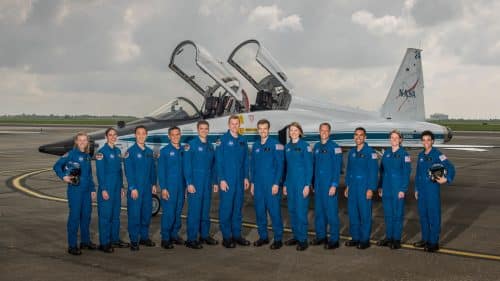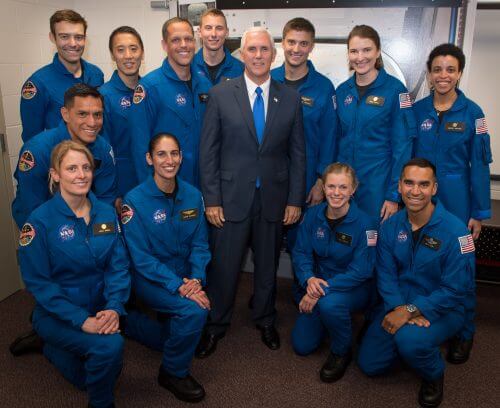NASA announced yesterday 12 new astronauts, chosen from a record number of 18,300 nominations submitted. Are these the people the agency will send to Mars in the future?

In a ceremony held yesterday, in the presence of the Vice President of the United States Mike Pence, NASA introduced its 12 new astronauts.
The new group of astronauts was selected from a record number of 18,300 nominations submitted to the agency. The previous record was recorded in 1978, in the period preceding the space shuttle era, when 8,000 nominations were submitted to the agency. The previous group of eight new astronauts, announced in 2013, was made from "only" 6,300 nominations.
The space agency does not yet consider the members of the new group active astronauts, but only candidates to become one. They will now begin a two-year training program, at the end of which they may join the 44 The active asteroids of the agency.
The training program will be held at the Johnson Space Center in Houston, Texas, where the ceremony was also held yesterday, which is responsible for training the NASA astronaut corps. As part of the program, the astronauts will be trained in the various systems related to the spacecraft that will be used by them and spacewalks. They will also learn the Russian language, which American astronauts are required to know because of the cooperation with Russia on the International Space Station.
The new astronauts will be launched to the space station on the commercial spacecrafts of Boeing and SpaceX, Starliner וDragon 2, respectively. The purpose of the spacecraft here To restore to the United States the ability to launch astronauts independently, which it lost in 2011 with the grounding of the space shuttles, and today it relies on Russia for this. First test flights of the new spacecraft are expected to take place next year.
The astronauts may also, according to NASA, go on journeys in "deep space", aboard the Orion spacecraft that NASA is developing - referring to missions beyond low-Earth orbit, whether in the vicinity of the Moon or Mars. NASA plans to carry out the first missions to Mars in the early 30s, and if it does succeed in realizing this ambitious goal, it is possible that the members of the new group will be the ones to participate in those missions (although surely additional groups of astronauts will be selected by then).

The ceremony was held with the participation of the Vice President of the United States Mike Pence, who also celebrated his 58th birthday yesterday. He congratulated the new astronauts, saying: "These are the 12 men and women whose personal excellence and individual heroism will carry our nation to even greater levels of discovery, and who I know will inspire our children and grandchildren, just as our forefathers did in this legendary American program." ".
In his words, Pence repeated the administration's intention, already on it announced in March this year, to re-establish the "National Space Council", which was dissolved in 1993 by President Bill Clinton. If President Donald Trump signs a presidential order ordering the establishment of the Revival Council, Mike Pence is expected to head it. The council was responsible for coordinating all the various bodies and aspects related to the American space program.
The new group is almost equally divided between women and men - seven men and five women, and their ages range from 29 to 42. As you might expect, each of the lucky winners, chosen from thousands who applied, has a very impressive biography. Among them are pilots in the American Air Force or Navy, doctors, scientists and even an engineer from SpaceX, whose spacecraft will be used by the new astronauts in the future.
The new astronauts are:
- Kayla Barron: 29, a combat officer in the nuclear submarines of the US Navy. Graduated with a master's degree in nuclear engineering from the University of Cambridge.
- Xena Cardman: 29, a marine biologist focusing on the study of microorganisms in subsurface environments. Graduated with a master's degree in marine sciences from the University of North Carolina.
- Raja Chari: 39, a test pilot in the US Air Force, who accumulated over 2,000 flight hours, and served actively in the Iraq War. Graduated with a master's degree in aeronautics and astronautics at MIT.
- Matthew (Matt) Dominick: 35, a pilot in the US Navy, with more than 1,600 flight hours in 28 different types of aircraft, and 61 combat missions. Graduated with a master's degree in systems engineering.
- Bob Haynes: 42, served for 18 years in the US Air Force, and for the last five years worked as a research pilot for NASA. Graduated with a master's degree in test flight engineering and another master's degree in aeronautics and space engineering.
- Warren (Woody) Hoburg: 31, Associate Professor of Aeronautics at MIT. Has a doctorate in electrical engineering and computer science from the University of California at Berkeley. private pilot
- Johnny Kim: 33, served in the "Sea Lions", the elite unit of the American Navy. Doctor of Medicine and graduate of Harvard Medical School.
- Rob Colin: 33, an engineer at SpaceX. Private pilot, with experience in commercial fishing and ice drilling in Antarctica. Has a PhD in engineering from the University of California, San Diego.
- Jasmine is limited: 33, a squadron in the US Navy, with more than 1,600 flight hours and 150 combat missions. Graduated with a master's degree in aeronautics and space engineering.
- Laurel O'Hara: 34, an engineer, with a master's degree in aeronautics and space engineering. A private squadron and a medic that helps in emergencies in remote natural areas.
- Frank Rubio: 41, military doctor and helicopter pilot, with over 1,100 flight hours. Served in Afghanistan, Iraq and Bosnia.
- Jessica Watkins: 29, PhD in Geology from UCLA. Participated in the Curiosity mission, NASA's robotic all-terrain vehicle exploring Mars.
See more on the subject on the science website:

6 תגובות
They will not return from Mars.
There are Jews 🙂
A. Ben Ner, everyone dies in the end the question is whether to die as a slimy plant in a nursing home or as a hero of humanity on another planet. And all space exploration and similar complicated tasks contribute to science and humanity even in things not related to space. For example solar panels, disease research and much more.
The problem with choosing astronauts is that you need people with physical fitness and endurance, hard builders, maybe in the future when there are more comfortable spaceships maybe they won't need it anymore and it will be possible to fly older and experienced scientists...
In addition, it should be noted that the chosen astronauts are professionals in practical and applied fields: engineering in its various branches, medicine, biology and geology.
What is missing in the selection?
No physicists, no mathematicians, no philosophers. There are no theorists.
There are no roadmaps, only mission operators.
His brothers-in-law are soldiers, operatives - not commanders, leaders.
Indeed talented people one by one, with an impressive personal record.
At the same time, I must point out that, in my opinion, an interview about sending people to Mars is an interview predestined for failure and disaster. An expensive disaster (in money) like no other, not to mention the loss of life of the astronauts who will participate in the journey to Mars.
In my estimation, while the chances of a successful landing on Mars are not high, but also not completely zero, the chances of returning from there and surviving on Mars are absolutely zero.
Aside from these, it is not expected that a human journey to Mars will bring a significant contribution to science, while the financial cost will be enormous.
It seems that the only reason for this megalomaniacal plan is NASA's public relations and fundraising.
It would have been better to devote these resources to the study of deep space and the study of the fundamental issues of science, (dark matter, dark energy, the big bang, the discovery of signs of extraterrestrial life, and more, and more...) using advanced far-sighted space telescopes.
All these, at much lower costs, will advance science by thousands compared to the Mars mission.
In addition, disasters and unnecessary loss of life will be avoided.